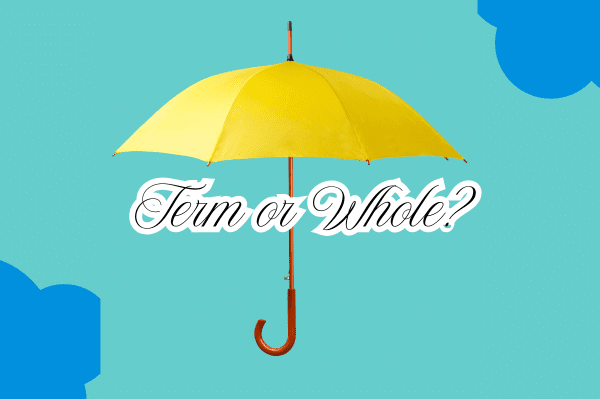Term vs. Whole Life Insurance: Which is Right for Your Financial Goals?

When it comes to protecting your family’s financial future, life insurance stands as a cornerstone of sound planning. However, navigating the choice between term and whole life insurance can be challenging. Each serves different purposes and aligns with different financial strategies. This guide breaks down these two primary types of life insurance, helping you determine which option best supports your unique financial goals.
Understanding the Fundamental Differences
Term and whole life insurance differ in several key aspects that impact their suitability for various financial objectives.
Term Life Insurance: Temporary Protection with Affordability
Term life insurance provides coverage for a specific period—typically 10, 20, or 30 years. If you pass away during this term, your beneficiaries receive the death benefit. If you outlive the term, the coverage ends unless you renew (usually at a higher premium) or convert to permanent insurance.
The primary feature of term insurance is its affordability. For the same coverage amount, term policies typically cost significantly less than whole life policies, often 5-15 times less in annual premiums. This cost advantage allows you to secure substantial coverage when your financial responsibilities are greatest.
Term insurance functions purely as protection without any additional components or cash accumulation features. Its simplicity makes it straightforward to understand and compare across providers.
Whole Life Insurance: Lifetime Coverage with Investment Features
Whole life insurance provides permanent coverage that lasts your entire lifetime, as long as premiums are paid. This permanence is its defining characteristic, ensuring your beneficiaries will receive a death benefit regardless of when you pass away.
Beyond the death benefit, whole life insurance includes a cash value component that grows over time. Part of each premium payment contributes to this cash value, which accumulates on a tax-deferred basis. Many whole life policies also pay dividends (though these aren’t guaranteed), which can increase the policy’s value over time.
The cash value becomes an asset you can access during your lifetime through policy loans or withdrawals, providing financial flexibility. However, these features come with significantly higher premiums compared to term insurance.
Financial Goals: Matching Insurance Type to Your Objectives
Your choice between term and whole life should align with your specific financial goals and circumstances.
When Term Life Insurance Aligns with Your Goals
Income Replacement During Peak Financial Responsibility Years
If your primary concern is protecting your family during the years when financial obligations are highest—such as while raising children or paying off a mortgage—term insurance excels. A term policy can provide substantial coverage during these crucial years at an affordable cost.
For example, a 35-year-old parent might purchase a 20-year term policy to ensure their children are financially protected until they become independent adults. The lower premiums allow for higher coverage amounts that can replace lost income and fund future expenses like college education.
Maximizing Coverage on a Limited Budget
When budget constraints exist but insurance needs are substantial, term insurance allows you to secure the highest possible death benefit for your premium dollars. This makes it ideal for young families who need significant protection but have limited disposable income.
The difference can be dramatic: A healthy 30-year-old might pay $25-30 monthly for a $500,000 20-year term policy, while a comparable whole life policy could cost $300-400 monthly.
Supplementing Employer Coverage
If you have some life insurance through your employer but need additional protection, term insurance can cost-effectively fill the gap. Since employer coverage often ends when employment does, a personal term policy provides continuity of protection regardless of job changes.
Covering Specific Debts or Obligations
Term insurance works well for covering specific financial obligations with defined time horizons. For instance, a 30-year term policy can be matched to a 30-year mortgage, ensuring the home loan could be paid off if something happened to you.
Practicing the “Buy Term and Invest the Difference” Strategy
Financial planners often recommend purchasing affordable term coverage and investing the premium savings (compared to whole life) in tax-advantaged retirement accounts or other investments. This strategy can potentially build more wealth over time than a whole life policy for disciplined investors, while still maintaining appropriate death benefit protection.
When Whole Life Insurance Aligns with Your Goals
Guaranteed Lifetime Coverage Needs
For those who anticipate needing life insurance protection throughout their entire lives, whole life provides certainty that coverage will remain in force regardless of health changes or age, provided premiums are paid. This makes it valuable for:
Parents of children with special needs who will require lifelong financial supportIndividuals with significant estate planning objectivesThose seeking to leave a guaranteed legacy regardless of longevity
Estate Planning and Wealth Transfer
Whole life insurance plays a unique role in estate planning. The death benefit passes to beneficiaries income tax-free and can provide liquidity to pay estate taxes without forcing the sale of other assets. For high-net-worth individuals, whole life insurance can fund estate taxes or equalize inheritances among heirs.
Building Tax-Advantaged Cash Value
The cash value component of whole life grows tax-deferred and can be accessed tax-free through policy loans (though these reduce the death benefit if not repaid). This tax treatment makes whole life attractive as a supplementary vehicle for those who:
Have maxed out contributions to other tax-advantaged accounts like 401(k)s and IRAsSeek additional tax-preferred savings opportunitiesWant an asset class uncorrelated with market performance
Business Continuation Planning
Whole life insurance serves important functions in business settings, such as funding buy-sell agreements between business partners or providing key person insurance with a cash value component that becomes a business asset.
Forced Savings Mechanism
For individuals who struggle with saving discipline, whole life’s required premium payments create a forced savings approach. While there are more efficient investment vehicles, some value the structured nature of whole life’s cash accumulation.
Hybrid Approaches and Considerations
Your insurance strategy doesn’t have to be an either/or decision. Many financial advisors recommend a layered approach combining both types of insurance.
The Ladder Strategy
A term insurance ladder involves purchasing multiple term policies with different end dates and coverage amounts. This approach provides higher coverage during years of greater financial responsibility, with decreasing coverage as obligations reduce. For example:
A 30-year $250,000 policy for mortgage protectionA 20-year $500,000 policy during child-raising yearsA 10-year $250,000 policy for other shorter-term obligations
The Base-Plus-Term Strategy
Another approach is establishing a modest whole life policy as a permanent base of coverage and financial flexibility, supplemented with term insurance for higher protection during peak responsibility years.
This strategy provides lifetime coverage and cash value benefits while keeping overall insurance costs manageable. As term policies expire, the whole life component remains, ensuring some coverage continues throughout life.
Convertible Term Insurance
Many term policies include a conversion option allowing you to convert some or all of your coverage to permanent insurance without new medical underwriting. This valuable feature preserves your insurability and provides flexibility to change strategies if your financial situation evolves.
Making Your Decision: Key Factors to Consider
When evaluating which type of life insurance best supports your financial goals, consider these critical factors:
Current and Future Financial Obligations
Assess your financial responsibilities—mortgage, education funding, income replacement needs—and their time horizons. Temporary obligations align well with term insurance, while permanent needs may warrant whole life coverage.
Budget Constraints
Be realistic about what premium you can consistently afford. It’s better to have adequate term coverage than to purchase insufficient whole life coverage or, worse, to let a policy lapse due to premium strain.
Investment Discipline and Options
If you’re disciplined about investing and have access to tax-advantaged retirement accounts with matching contributions, term insurance plus separate investments often creates more wealth than whole life insurance. If you struggle with saving discipline, whole life’s forced savings component might provide value.
Health Considerations
If you have health issues that might make insurance more difficult or expensive to obtain later, securing permanent coverage while insurable could be strategic. Conversely, if you’re healthy but on a tight budget, term insurance with a conversion option preserves future flexibility.
Estate Planning Needs
Consider whether you expect to have estate tax liability or specific legacy objectives. Whole life insurance can play a valuable role in larger estate plans, particularly for high-net-worth individuals.
The Bottom Line
Neither term nor whole life insurance is inherently superior—each serves different purposes in a financial plan. Term insurance excels at providing maximum death benefit protection per premium dollar during specific periods of financial vulnerability. Whole life insurance combines lifetime protection with tax-advantaged cash value accumulation and additional features at a higher cost.
Your optimal choice depends on your unique financial goals, family situation, budget, and long-term objectives. Many financial professionals recommend starting with term insurance to ensure adequate protection is in place, then considering permanent insurance for specific purposes as your financial situation allows.
Before making your decision, consider consulting with a financial advisor who can analyze your complete financial picture and help structure an insurance strategy that complements your other financial planning elements. The right combination of insurance products should provide peace of mind while supporting your broader financial goals, both for protection today and financial flexibility tomorrow.




